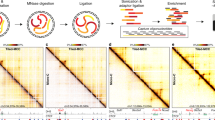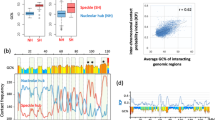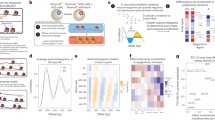Abstract
Chromatin folding contributes to the regulation of genomic processes such as gene activity. Existing conformation capture methods characterize genome topology through analysis of pairwise chromatin contacts in populations of cells but cannot discern whether individual interactions occur simultaneously or competitively. Here we present multi-contact 4C (MC-4C), which applies Nanopore sequencing to study multi-way DNA conformations of individual alleles. MC-4C distinguishes cooperative from random and competing interactions and identifies previously missed structures in subpopulations of cells. We show that individual elements of the β-globin superenhancer can aggregate into an enhancer hub that can simultaneously accommodate two genes. Neighboring chromatin domain loops can form rosette-like structures through collision of their CTCF-bound anchors, as seen most prominently in cells lacking the cohesin-unloading factor WAPL. Here, massive collision of CTCF-anchored chromatin loops is believed to reflect ‘cohesin traffic jams’. Single-allele topology studies thus help us understand the mechanisms underlying genome folding and functioning.
This is a preview of subscription content, access via your institution
Access options
Access Nature and 54 other Nature Portfolio journals
Get Nature+, our best-value online-access subscription
$29.99 / 30 days
cancel any time
Subscribe to this journal
Receive 12 print issues and online access
$209.00 per year
only $17.42 per issue
Buy this article
- Purchase on Springer Link
- Instant access to full article PDF
Prices may be subject to local taxes which are calculated during checkout





Similar content being viewed by others
References
Dekker, J., Rippe, K., Dekker, M. & Kleckner, N. Capturing chromosome conformation. Science 295, 1306–1311 (2002).
Denker, A. & de Laat, W. The second decade of 3C technologies: detailed insights into nuclear organization. Genes Dev. 30, 1357–1382 (2016).
Dixon, J. R. et al. Topological domains in mammalian genomes identified by analysis of chromatin interactions. Nature 485, 376–380 (2012).
Nora, E. P. et al. Spatial partitioning of the regulatory landscape of the X-inactivation centre. Nature 485, 381–385 (2012).
Sexton, T. et al. Three-dimensional folding and functional organization principles of the Drosophila genome. Cell 148, 458–472 (2012).
Lieberman-Aiden, E. et al. Comprehensive mapping of long-range interactions reveals folding principles of the human genome. Science 326, 289–293 (2009).
Dekker, J. & Mirny, L. The 3D genome as moderator of chromosomal communication. Cell 164, 1110–1121 (2016).
Dixon, J. R., Gorkin, D. U. & Ren, B. Chromatin domains: the unit of chromosome organization. Mol. Cell 62, 668–680 (2016).
Rao, S. S. et al. A 3D map of the human genome at kilobase resolution reveals principles of chromatin looping. Cell 159, 1665–1680 (2014).
Hanscombe, O. et al. Importance of globin gene order for correct developmental expression. Genes Dev. 5, 1387–1394 (1991).
Tolhuis, B., Palstra, R. J., Splinter, E., Grosveld, F. & de Laat, W. Looping and interaction between hypersensitive sites in the active beta-globin locus. Mol. Cell 10, 1453–1465 (2002).
Gavrilov, A. A., Chetverina, H. V., Chermnykh, E. S., Razin, S. V. & Chetverin, A. B. Quantitative analysis of genomic element interactions by molecular colony technique. Nucleic Acids Res. 42, e36 (2014).
Ay, F. et al. Identifying multi-locus chromatin contacts in human cells using tethered multiple 3C. BMC Genom. 16, 121 (2015).
Olivares-Chauvet, P. et al. Capturing pairwise and multi-way chromosomal conformations using chromosomal walks. Nature 540, 296–300 (2016).
Darrow, E. M. et al. Deletion of DXZ4 on the human inactive X chromosome alters higher-order genome architecture. Proc. Natl. Acad. Sci.USA 113, E4504–E4512 (2016).
Beagrie, R. A. et al. Complex multi-enhancer contacts captured by genome architecture mapping. Nature 543, 519–524 (2017).
Splinter, E., de Wit, E., van de Werken, H. J., Klous, P. & de Laat, W. Determining long-range chromatin interactions for selected genomic sites using 4C-seq technology: from fixation to computation. Methods 58, 221–230 (2012).
van de Werken, H. J. et al. 4C technology: protocols and data analysis. Methods Enzymol. 513, 89–112 (2012).
de Vree, P. J. et al. Targeted sequencing by proximity ligation for comprehensive variant detection and local haplotyping. Nat. Biotechnol. 32, 1019–1025 (2014).
Haarhuis, J. H. I. et al. The cohesin release factor WAPL restricts chromatin loop extension. Cell 169, 693–707.e14 (2017).
Pott, S. & Lieb, J. D. What are super-enhancers? Nat. Genet. 47, 8–12 (2015).
Dukler, N., Gulko, B., Huang, Y. F. & Siepel, A. Is a super-enhancer greater than the sum of its parts? Nat. Genet. 49, 2–3 (2016).
Huang, J. et al. Dissecting super-enhancer hierarchy based on chromatin interactions. Nat. Commun. 9, 943 (2018).
Bender, M. A., Bulger, M., Close, J. & Groudine, M. Beta-globin gene switching and DNase I sensitivity of the endogenous beta-globin locus in mice do not require the locus control region. Mol. Cell 5, 387–393 (2000).
Hu, X. et al. Transcriptional interference among the murine beta-like globin genes. Blood 109, 2210–2216 (2007).
Cadiz-Rivera, B. et al. The chromatin “landscape” of a murine adult β-globin gene is unaffected by deletion of either the gene promoter or a downstream enhancer. PLoS One 9, e92947 (2014).
van de Werken, H. J. et al. Robust 4C-seq data analysis to screen for regulatory DNA interactions. Nat. Methods 9, 969–972 (2012).
Davies, J. O. et al. Multiplexed analysis of chromosome conformation at vastly improved sensitivity. Nat. Methods 13, 74–80 (2016).
Giresi, P. G., Kim, J., McDaniell, R. M., Iyer, V. R. & Lieb, J. D. FAIRE (Formaldehyde-Assisted Isolation of Regulatory Elements) isolates active regulatory elements from human chromatin. Genome Res. 17, 877–885 (2007).
Esumi, S. et al. Monoallelic yet combinatorial expression of variable exons of the protocadherin-alpha gene cluster in single neurons. Nat. Genet. 37, 171–176 (2005).
Hirayama, T. & Yagi, T. The role and expression of the protocadherin-alpha clusters in the CNS. Curr. Opin. Neurobiol. 16, 336–342 (2006).
Kehayova, P., Monahan, K., Chen, W. & Maniatis, T. Regulatory elements required for the activation and repression of the protocadherin-alpha gene cluster. Proc. Natl. Acad. Sci. USA 108, 17195–17200 (2011).
Yokota, S. et al. Identification of the cluster control region for the protocadherin-beta genes located beyond the protocadherin-gamma cluster. J. Biol. Chem. 286, 31885–31895 (2011).
Guo, Y. et al. CTCF/cohesin-mediated DNA looping is required for protocadherin α promoter choice. Proc.Natl. Acad. Sci. USA 109, 21081–21086 (2012).
Toyoda, S. et al. Developmental epigenetic modification regulates stochastic expression of clustered protocadherin genes, generating single neuron diversity. Neuron 82, 94–108 (2014).
Sofueva, S. et al. Cohesin-mediated interactions organize chromosomal domain architecture. EMBO J. 32, 3119–3129 (2013).
Rao, S. S. P. et al. Cohesin loss eliminates all loop domains. Cell 171, 305–320.e24 (2017).
Fudenberg, G. et al. Formation of chromosomal domains by loop extrusion. Cell Rep. 15, 2038–2049 (2016).
Sanborn, A. L. et al. Chromatin extrusion explains key features of loop and domain formation in wild-type and engineered genomes. Proc. Natl. Acad. Sci. USA 112, E6456–E6465 (2015).
Tedeschi, A. et al. Wapl is an essential regulator of chromatin structure and chromosome segregation. Nature 501, 564–568 (2013).
Nakayama, T. et al. Cas9-based genome editing in Xenopus tropicalis. Methods Enzymol 546, 355–375 (2014).
Kaneko, R. et al. Allelic gene regulation of Pcdh-α and Pcdh-γ clusters involving both monoallelic and biallelic expression in single Purkinje cells. J. Biol. Chem. 281, 30551–30560 (2006).
Loman, N. J. & Quinlan, A. R. Poretools: a toolkit for analyzing nanopore sequence data. Bioinformatics 30, 3399–3401 (2014).
Langmead, B. & Salzberg, S. L. Fast gapped-read alignment with Bowtie 2. Nat. Methods 9, 357–359 (2012).
Li, H. & Durbin, R. Fast and accurate long-read alignment with Burrows-Wheeler transform. Bioinformatics 26, 589–595 (2010).
Acknowledgements
We thank the Utrecht Sequencing Facility for providing sequencing data and service, E. Schijlen for help with initial Pacific Biosciences sequencing, and D. Leyton-Puig for help with imaging. We thank N. Geijsen and P. Shang (Hubrecht Institute) for providing Cas9 protein. This work was supported by an NWO VIDI grant (639.072.715) to J.d.R. and an NWO/CW TOP grant (714.012.002) and NWO VICI grant (724.012.003) to W.d.L. and by the NIH Common Fund Program, grant U01CA200147, as a Transformative Collaborative Project Award (TCPA, TCPA-2017-DE-LAAT).
Author information
Authors and Affiliations
Contributions
A.A. designed and performed the computational analysis, prepared corresponding plots and wrote the methods and Supplementary Information sections. C.V. and B.A.M.B. designed and performed experiments. C.V. wrote the manuscript and designed figures. P.H.L.K., M.J.A.M.V., M.v.K., M.P. and H.T. performed ‘C’ methods experiments. R.S. implemented the pipeline in Python. J.H.I.H. generated ∆WAPL cell lines and prepared microscopic slides for super-resolution imaging. K.J. guided acquisition and analyzed super-resolution microscopy data. I.J.R. performed and W.P.K. designed and supervised MinION sequencing experiments. B.D.R. supervised the generation of ∆WAPL cell lines and preparation of microscopic slides for super-resolution imaging. G.G. and E.d.W. helped with computational analysis. E.d.W. performed data analysis on the ΔWAPL Hi-C data. J.d.R. designed and supervised the computational analyses and pipelines and cowrote the manuscript. W.d.L. conceived and supervised the study and wrote the manuscript.
Corresponding authors
Ethics declarations
Competing Interests
C.V., B.A.M.B., P.H.L.K., M.J.A.M.V. and G.G. are shareholders of Cergentis. E.d.W. is cofounder and shareholder of Cergentis. W.d.L. is founder and shareholder of Cergentis. J.d.R. is cofounder and shareholder of Cyclomics.
Additional information
Publisher’s note: Springer Nature remains neutral with regard to jurisdictional claims in published maps and institutional affiliations.
Supplementary information
Supplementary Figures
Supplementary Figures 1–16
Supplementary Table 1
Statistics of the MC-4C experiments. Shown, per experiment, are the total number of reads sequenced per experiment (Raw read column), number of reads with more than one fragment—excluding VP—in the region of interest (Informative), number of reads with at least one unique molecular identifier fragment allowing a check for PCR duplication (Has far cis/trans UMI), number of independent alleles after removing PCR duplicates (PCR filtered unique reads), and the number of MinION sequencing runs that were pooled for each experiment (Sequence runs). The numbers in parentheses are percentage of reads remaining after each step of filtering compared to total number of reads sequenced
Supplementary Table 2
Primers used in this study. The primers used for each individual viewpoint, and the coordinates of each region of interest. FW and RV primers are used for MC-4C PCR; A and B refer to the FW primer used to synthesize the gRNA for the upstream and downstream neighboring fragment (respectively) of the viewpoint; VP is the primer used to synthesize the gRNA designed on the viewpoint fragment
Rights and permissions
About this article
Cite this article
Allahyar, A., Vermeulen, C., Bouwman, B.A.M. et al. Enhancer hubs and loop collisions identified from single-allele topologies. Nat Genet 50, 1151–1160 (2018). https://doi.org/10.1038/s41588-018-0161-5
Received:
Accepted:
Published:
Issue Date:
DOI: https://doi.org/10.1038/s41588-018-0161-5
This article is cited by
-
Computational methods for analysing multiscale 3D genome organization
Nature Reviews Genetics (2024)
-
Boundary stacking interactions enable cross-TAD enhancer–promoter communication during limb development
Nature Genetics (2024)
-
3D Enhancer–promoter networks provide predictive features for gene expression and coregulation in early embryonic lineages
Nature Structural & Molecular Biology (2024)
-
Oncogenic enhancers prime quiescent metastatic cells to escape NK immune surveillance by eliciting transcriptional memory
Nature Communications (2024)
-
Beyond assembly: the increasing flexibility of single-molecule sequencing technology
Nature Reviews Genetics (2023)



